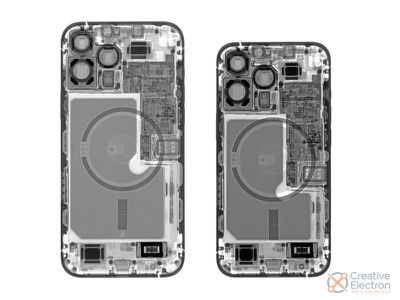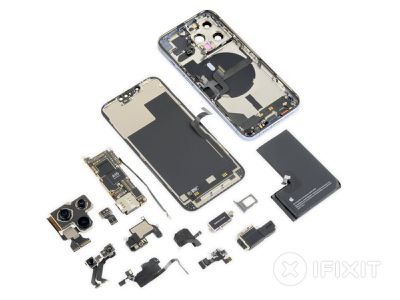 1237
1237
 2021-09-28
2021-09-28
iFixit has started one of its traditional full device teardowns on the new iPhone 13 Pro, giving us a complete look at all of the components that are inside.

Prior to taking a look inside the new iPhone, iFixit did X-rays to show off the L-shaped battery, the MagSafe magnet ring, and stabilizing magnets for image sensors and logic boards.
This year's iPhone 13 Pro has an upper sensor cable near the top that's easy to rip during repairs, with iFixit calling it "scary thin." Visually, the Taptic Engine inside the device that controls Haptic Touch appears to be smaller, but it's actually bulkier than the similar component in the iPhone 13 Pro, weighing in at 6.3 grams, up from 4.8.
Compared to the iPhone 12 Pro, the iPhone 13 Pro does away with the display-mounted speaker earpiece, a move that will make display replacements easier. iFixit suspects that Apple is using touch-integrated OLED panels that combine the touch and OLED layers of the display, cutting down on cost, thickness, and the number of cables to deal with.
The iPhone 13's flood illuminator and dot projector have merged into one module, which is part of the reason why Apple was able to cut down the size of the notch on this year's iPhones, and the Face ID hardware is now independent of the display. The earpiece speaker that was removed from the display has been relocated between the front-facing camera and the Face ID module.
According to iFixit, despite the decoupling of the Face ID module and the display, any display replacement disables Face ID. This means that screen replacements not authorized by Apple will result in non-functional Face ID components.
As we found out last week, the iPhone 13 Pro is using an 11.97Wh battery, which equates to 3,095mAh, up from 2,815mAh in the iPhone 12 Pro. The battery in the iPhone 13 Pro has an L-shaped design this year, a departure from the rectangular battery used in last year's Pro model. iFixit says that battery swap tests have been successful, despite rumors that battery replacements wouldn't be possible.
There's 6GB SK Hynix LPDDR4X RAM inside, along with several Apple-designed power management and ultra-wide band chips, and as expected, the iPhone 13 Pro is equipped with Qualcomm's SDX60M modem and what iFixit believes is a Qualcomm DRR868 5G RF transceiver.

Apple analyst Ming-Chi Kuo said that the Qualcomm modem chip in this year's iPhones has satellite communication functionality, but if it's in there, iFixit didn't notice and as no satellite feature has been announced, it's a latent function if it exists. Bloomberg has clarified that Apple is working on a satellite feature that will let people send texts in emergency situations using a satellite connection, but this functionality isn't expected until 2022.
Moving on, the iPhone 13 Pro features Kioxia NAND Flash memory, a front-end module from Broadcom, an NXP Semiconductor NFC controller, and more.
iFixit's full teardown has more detail on all of the components that are inside the device, and iFixit ultimately gave the iPhone 13 Pro a repairability score of 5 out of 10 due to the Face ID display replacement issue, the double glass, and the waterproofing methods that make some repairs more difficult.
Source: Macrumors